 If you’re a modern, go-getting metrosexual-about-town like us Digi-Life hipsters, you’ll be the owner of a mile-long list of passwords, web logins, ATM PINs, program serials, bank account details, credit card numbers and passcodes for highly exclusive West End nightclubs.
If you’re a modern, go-getting metrosexual-about-town like us Digi-Life hipsters, you’ll be the owner of a mile-long list of passwords, web logins, ATM PINs, program serials, bank account details, credit card numbers and passcodes for highly exclusive West End nightclubs.
Remembering all those numbers and passwords isn’t the easiest thing to do when you’re out and about, so it would be handy to be able to carry them all about on your smartphone, in a safe and secure way that will keep all your personal data safe if your phone gets purloined.
The best way to do this is to use a password-protected Password Manager that keeps all your personal info under lock and key, leaving you with just one password to remember.
Although there’s a ton of password managers available for smartphones/PDAs, we haven’t found any that do it as well as Splash ID – we’ve been using the program for several years and find it absolutely indispensable.
 Using SplashID
Using SplashID
Available for the Palm OS, Treo, Pocket PC, Windows Mobile Smartphone, Symbian UIQ, Series 60 and BlackBerry, SplashID securely stores all of your sensitive personal information in a database protected by 256-bit Blowfish encryption.
Launching the program on your handheld brings up a password request, and once you’ve inputted the right digits, you can access all your data alphabetically, by category or by searching.
Using its clean and simple interface, user names, passwords, credit cards, PINs, and other such personal information can be inputted on your handheld, with the option to include categories, create custom fields and assign icons in a colour-coded customisable List View.
 Naturally, with all your precious data a mere password away, it’s vital that you make your SplashID password a good ‘un – if that kind of thing defeats you, there’s a handy password generator onboard to help you create hard-to-crack passwords.
Naturally, with all your precious data a mere password away, it’s vital that you make your SplashID password a good ‘un – if that kind of thing defeats you, there’s a handy password generator onboard to help you create hard-to-crack passwords.
Desktop application
Best of all, Splash ID ships with a password protected desktop companion and conduit that lets you store, add and edit data information stored in the database.
It’s a neat, small application that replicates the functionality of the handheld application, accessible with the same password.
 A nice touch is that you can click the clipboard icon next to listed passwords and have the code automatically placed in the clipboard ready for pasting into your browser or program password box.
A nice touch is that you can click the clipboard icon next to listed passwords and have the code automatically placed in the clipboard ready for pasting into your browser or program password box.
Conclusion
Whenever we’ve upgraded our phone or PDA in the past, this is one of the very first programs we install – it’s that good.
 Because of SplashID’s cross-platform abilities, we’ve been able to exchange data from Palm to Windows Mobile devices (and back again) without a problem so it’s pretty much future proofed, and the desktop integration is a great way of ensuring that the info is kept up to date.
Because of SplashID’s cross-platform abilities, we’ve been able to exchange data from Palm to Windows Mobile devices (and back again) without a problem so it’s pretty much future proofed, and the desktop integration is a great way of ensuring that the info is kept up to date.
The program is simple to use and offers a convenient, secure and versatile way of safely storing passwords on your mobile, and we reckon $30 (£16, €23) is a small price to pay for such peace of mind.
Features: 90%
Ease of use: 85%
Value For Money: 85%
Overall: 90%
SplashID
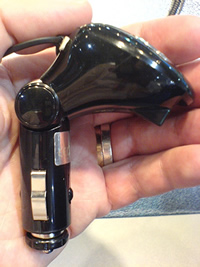 There are a couple of dilemmas for anyone who takes their MP3 player to play in the car. How do you get the sound to the car stereo and how do you stop the thing sliding about all over the place? The TrekStor MP3-RadioStation f.ox tackles these.
There are a couple of dilemmas for anyone who takes their MP3 player to play in the car. How do you get the sound to the car stereo and how do you stop the thing sliding about all over the place? The TrekStor MP3-RadioStation f.ox tackles these. Where do the tunes come from? There’s no storage on board, as the music is supplied via a USB memory stick that plugs in the bottom. This arrangement brings the advantage of low cost expansion and that the music storage is only limited by the size and number of memory sticks you’ve got.
Where do the tunes come from? There’s no storage on board, as the music is supplied via a USB memory stick that plugs in the bottom. This arrangement brings the advantage of low cost expansion and that the music storage is only limited by the size and number of memory sticks you’ve got.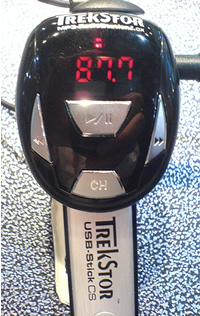 Sadly for UK users, devices like this can’t be used legally, as Ofcom don’t differentiate between low-power gadgets such as this that transmit over a short distance and a full blown radio station.
Sadly for UK users, devices like this can’t be used legally, as Ofcom don’t differentiate between low-power gadgets such as this that transmit over a short distance and a full blown radio station.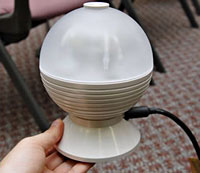 We can’t say we like the thought of being bombarded by different whiffs while we’re listening to the radio, but it seems someone in Japan liked the idea so much that they’re about to launch a fragrance-pumpin’ product in October.
We can’t say we like the thought of being bombarded by different whiffs while we’re listening to the radio, but it seems someone in Japan liked the idea so much that they’re about to launch a fragrance-pumpin’ product in October. The gadget connects to your desktop via USB, with the PC downloading the aroma instructions from the radio station via the Internet, with odorous wafts synchronised to match whatever song is currently being played.
The gadget connects to your desktop via USB, with the PC downloading the aroma instructions from the radio station via the Internet, with odorous wafts synchronised to match whatever song is currently being played. The USB Aroma Geur is available for 49,900 Yen ($430), with the service scheduled to start up in Japan from 2nd October 2006.
The USB Aroma Geur is available for 49,900 Yen ($430), with the service scheduled to start up in Japan from 2nd October 2006. During an interview with Digital-Lifestyles [
During an interview with Digital-Lifestyles [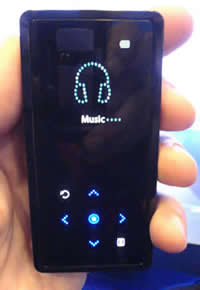 During his keynote, Gee Sung Choi, President and CEO of Samsung announced the launch of the YP-5K, a very slick MP3 player with built-in pivoting speaker, letting you ‘entertain’ your friends or fellow train passengers.
During his keynote, Gee Sung Choi, President and CEO of Samsung announced the launch of the YP-5K, a very slick MP3 player with built-in pivoting speaker, letting you ‘entertain’ your friends or fellow train passengers.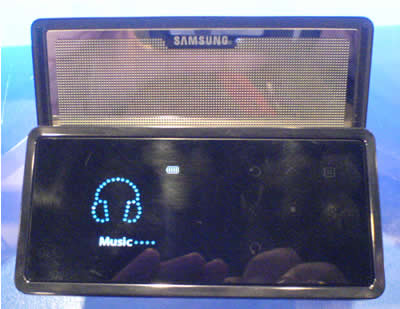
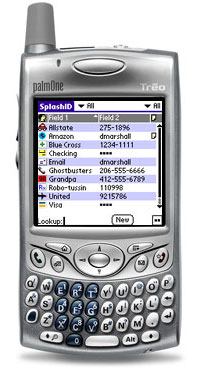 If you’re a modern, go-getting metrosexual-about-town like us Digi-Life hipsters, you’ll be the owner of a mile-long list of passwords, web logins, ATM PINs, program serials, bank account details, credit card numbers and passcodes for highly exclusive West End nightclubs.
If you’re a modern, go-getting metrosexual-about-town like us Digi-Life hipsters, you’ll be the owner of a mile-long list of passwords, web logins, ATM PINs, program serials, bank account details, credit card numbers and passcodes for highly exclusive West End nightclubs.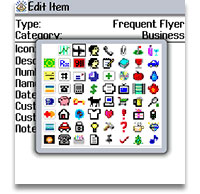 Using SplashID
Using SplashID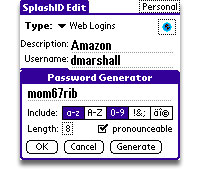 Naturally, with all your precious data a mere password away, it’s vital that you make your SplashID password a good ‘un – if that kind of thing defeats you, there’s a handy password generator onboard to help you create hard-to-crack passwords.
Naturally, with all your precious data a mere password away, it’s vital that you make your SplashID password a good ‘un – if that kind of thing defeats you, there’s a handy password generator onboard to help you create hard-to-crack passwords.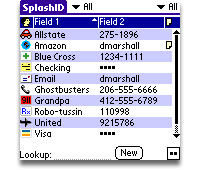 A nice touch is that you can click the clipboard icon next to listed passwords and have the code automatically placed in the clipboard ready for pasting into your browser or program password box.
A nice touch is that you can click the clipboard icon next to listed passwords and have the code automatically placed in the clipboard ready for pasting into your browser or program password box.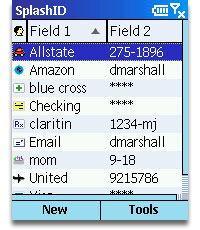 Because of SplashID’s cross-platform abilities, we’ve been able to exchange data from Palm to Windows Mobile devices (and back again) without a problem so it’s pretty much future proofed, and the desktop integration is a great way of ensuring that the info is kept up to date.
Because of SplashID’s cross-platform abilities, we’ve been able to exchange data from Palm to Windows Mobile devices (and back again) without a problem so it’s pretty much future proofed, and the desktop integration is a great way of ensuring that the info is kept up to date.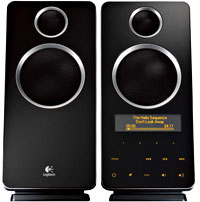 Although speakers are an essential part of any gadget lovers set up, let’s be honest: they’re a bit boring to look at.
Although speakers are an essential part of any gadget lovers set up, let’s be honest: they’re a bit boring to look at.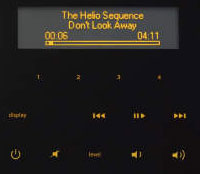 Well, we actually already use one of their keyboards that does just that, but we’re sure that some folks may appreciate being able to adjust volume, treble and bass, and play, pause, skip forward and jump back through tracks from the comfort of their, err, speaker.
Well, we actually already use one of their keyboards that does just that, but we’re sure that some folks may appreciate being able to adjust volume, treble and bass, and play, pause, skip forward and jump back through tracks from the comfort of their, err, speaker.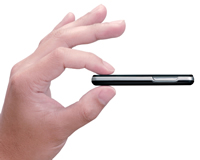 As we’ve all witnessed, Apple’s Nano is a beauty to both behold and hold. The whole industry has been gunning for Apple, ever since they realised that Apple had shifted the market. We’ve seen many attempts to put out devices to match or catch them, only to watch them fall by the wayside..
As we’ve all witnessed, Apple’s Nano is a beauty to both behold and hold. The whole industry has been gunning for Apple, ever since they realised that Apple had shifted the market. We’ve seen many attempts to put out devices to match or catch them, only to watch them fall by the wayside.. What’s it like?
What’s it like?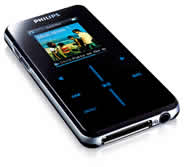 There’s going to be an optional docking station that works with the newly-upgraded Streamium, WiFi HiFi. Once the GoGear (a nifty name, the more you say it) is docked, its track list appears on the streamium and tunes can be played through it.
There’s going to be an optional docking station that works with the newly-upgraded Streamium, WiFi HiFi. Once the GoGear (a nifty name, the more you say it) is docked, its track list appears on the streamium and tunes can be played through it.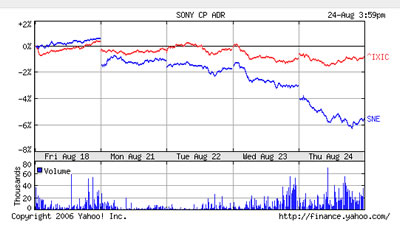
 We’ve all known for years that PVR’s have been eating TV advertising. Murdoch has been on top of this for ages too, which makes it all the more interesting to hear that his Fox network is using 2-second Blinks, adverts.
We’ve all known for years that PVR’s have been eating TV advertising. Murdoch has been on top of this for ages too, which makes it all the more interesting to hear that his Fox network is using 2-second Blinks, adverts.  Overall, Clear Channel Radio has experienced mixed results following Less Is More, though recent quarters have shown positive revenue increases. Clear Channel executives have credited those jumps to the shortened advertising slots, which address a major source of radio listener irritation.
Overall, Clear Channel Radio has experienced mixed results following Less Is More, though recent quarters have shown positive revenue increases. Clear Channel executives have credited those jumps to the shortened advertising slots, which address a major source of radio listener irritation. Desktop computing will be dead by the end of the decade and laptops will be following shortly after. That was the view of Graham Brown-Martin of Handheld Learning in an entertaining presentation at day two of the EIEF.
Desktop computing will be dead by the end of the decade and laptops will be following shortly after. That was the view of Graham Brown-Martin of Handheld Learning in an entertaining presentation at day two of the EIEF. As an illustration of this, and of his extremely cool mobile phone, Brown-Martin demonstrated a home made remix of the Snakes on a Plane teaser, edited with a mobile and a Macbook. The result was uploaded directly to YouTube from the phone then downloaded again (wirelessly) using a Nokia Internet tablet.
As an illustration of this, and of his extremely cool mobile phone, Brown-Martin demonstrated a home made remix of the Snakes on a Plane teaser, edited with a mobile and a Macbook. The result was uploaded directly to YouTube from the phone then downloaded again (wirelessly) using a Nokia Internet tablet.